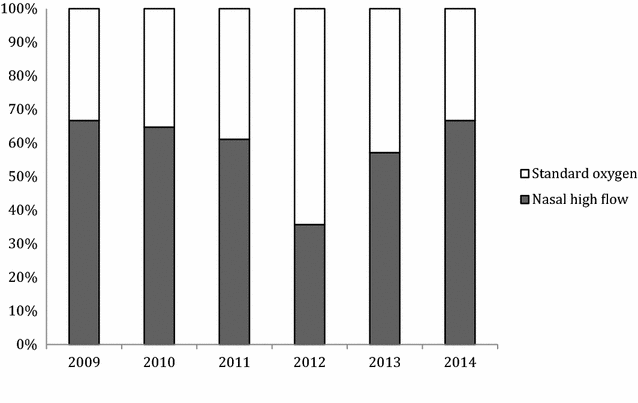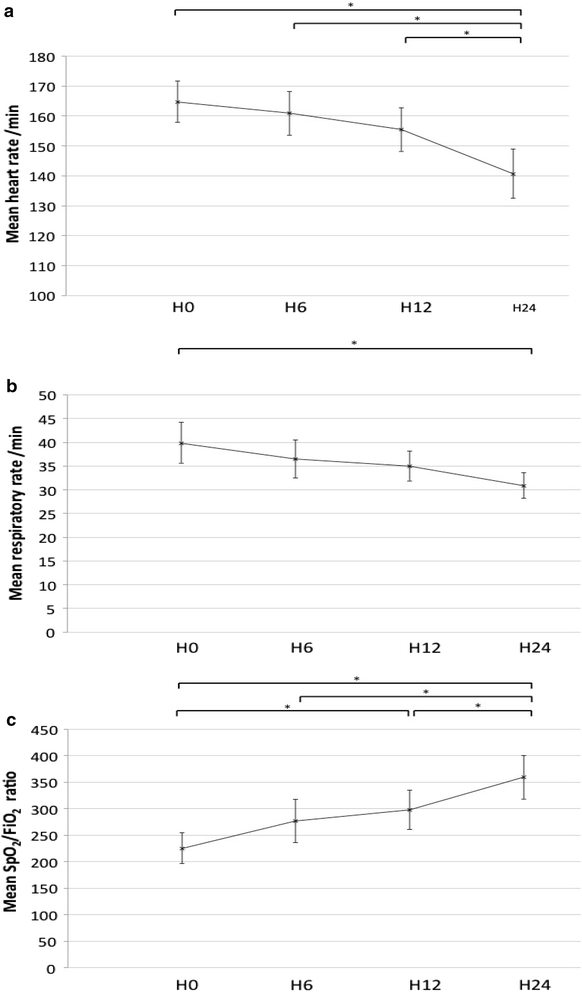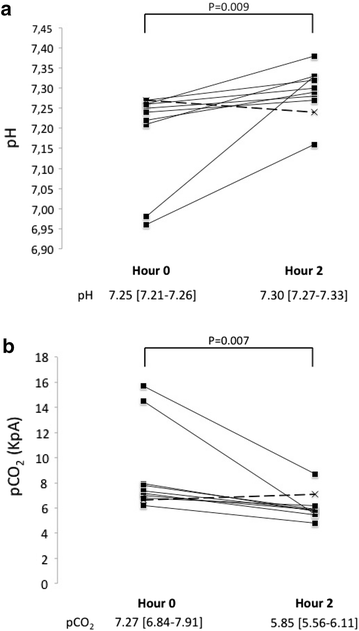Nasal high flow in management of children with status asthmaticus: a retrospective observational study
- PMID: 28534235
- PMCID: PMC5440424
- DOI: 10.1186/s13613-017-0278-1
Nasal high flow in management of children with status asthmaticus: a retrospective observational study
Abstract
Background: Asthma is the most common obstructive airway disease in children and adults. Nasal high flow (NHF) is a recent device that is now used as a primary support for respiratory distress. Several studies have reported use of NHF as a respiratory support in status asthmaticus; however, there are no data to recommend such practice. We therefore conducted this preliminary study to evaluate NHF therapy for children with status asthmaticus admitted to our PICU in order to prepare a multicentre randomized controlled study.
Results: Between November 2009 and January 2014, 73 patients with status asthmaticus were admitted to the PICU, of whom 39 (53%) were treated with NHF and among these 10 (26%) presented severe acidosis at admission (pH < 7.30). Thirty-four less severe children (41%) were treated with standard oxygen. For one child (2.6%) NHF failed and was then switched to non-invasive ventilation. NHF was discontinued in another patient because of the occurrence of pneumothorax after 31 h with NHF; the patient was then switched to standard oxygen therapy. Mean ± SD heart rate (165 ± 21 vs. 141 ± 25/min, p < 0.01) and respiratory rate (40 ± 13 vs. 31 ± 8/min, p < 0.01) decreased significantly, and blood gas improved in the first 24 h. In the subgroup of patients with acidosis, median [IQR] pH increased significantly between hour 0 and 2 (7.25 [7.21-7.26] vs. 7.30 [7.27-7.33], p = 0.009) and median [IQR] pCO2 decreased significantly (7.27 kPa [6.84-7.91 vs. 5.85 kPa [5.56-6.11], p = 0.007). No patient was intubated.
Conclusion: This retrospective study showed the feasibility and safety of NHF in children with severe asthma. Blood gas and clinical parameters were significantly improved during the first 24 h. NHF failed in only two patients, and none required invasive ventilation.
Keywords: Asthma; Children; High-flow nasal cannula; Non-invasive ventilation; Paediatric intensive care unit.
Figures




Similar articles
-
Nasal highflow improves ventilation in patients with COPD.Int J Chron Obstruct Pulmon Dis. 2016 May 25;11:1077-85. doi: 10.2147/COPD.S104616. eCollection 2016. Int J Chron Obstruct Pulmon Dis. 2016. PMID: 27307723 Free PMC article. Clinical Trial.
-
Patient origin is associated with duration of endotracheal intubation and PICU length of stay for children with status asthmaticus.J Intensive Care Med. 2014 May-Jun;29(3):154-9. doi: 10.1177/0885066613476446. Epub 2013 Feb 11. J Intensive Care Med. 2014. PMID: 23753230 Review.
-
High-flow nasal cannula therapy versus non-invasive ventilation in children with severe acute asthma exacerbation: An observational cohort study.Med Intensiva. 2017 Oct;41(7):418-424. doi: 10.1016/j.medin.2017.01.001. Epub 2017 Feb 16. Med Intensiva. 2017. PMID: 28216104 English, Spanish.
-
Nasal high-flow therapy compared with non-invasive ventilation in COPD patients with chronic respiratory failure: A randomized controlled cross-over trial.Respirology. 2019 Nov;24(11):1081-1087. doi: 10.1111/resp.13575. Epub 2019 May 13. Respirology. 2019. PMID: 31083777 Clinical Trial.
-
[Nasal Highflow (NHF): A New Therapeutic Option for the Treatment of Respiratory Failure].Pneumologie. 2016 Jan;70(1):49-54. doi: 10.1055/s-0041-110286. Epub 2016 Jan 20. Pneumologie. 2016. PMID: 26789432 Review. German.
Cited by
-
The efficacy of high-flow oxygen versus conventional oxygen for asthma control: a meta-analysis of randomized controlled studies.Postepy Dermatol Alergol. 2022 Dec;39(6):1077-1082. doi: 10.5114/ada.2022.119074. Epub 2022 Sep 7. Postepy Dermatol Alergol. 2022. PMID: 36686026 Free PMC article.
-
Narrative review of practical aspects of aerosol delivery via high-flow nasal cannula.Ann Transl Med. 2021 Apr;9(7):590. doi: 10.21037/atm-20-7383. Ann Transl Med. 2021. PMID: 33987288 Free PMC article. Review.
-
In vitro comparison between inspiration synchronized and continuous vibrating mesh nebulizer during trans-nasal aerosol delivery.Intensive Care Med Exp. 2020 Jan 31;8(1):6. doi: 10.1186/s40635-020-0293-7. Intensive Care Med Exp. 2020. PMID: 32006290 Free PMC article.
-
Comparison of the effects of high-flow nasal cannula and bilevel positive airway pressure treatments as respiratory physiotherapy interventions for children with asthma exacerbation: a randomized clinical trial.Einstein (Sao Paulo). 2024 Aug 26;22:eAO0588. doi: 10.31744/einstein_journal/2024AO0588. eCollection 2024. Einstein (Sao Paulo). 2024. PMID: 39194097 Free PMC article. Clinical Trial.
-
Comparative study between local anesthesia and general anesthesia in the treatment of primary spontaneous pneumothorax.Ann Transl Med. 2019 Oct;7(20):553. doi: 10.21037/atm.2019.09.89. Ann Transl Med. 2019. PMID: 31807534 Free PMC article.
References
LinkOut - more resources
Full Text Sources
Other Literature Sources
Medical

